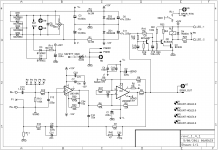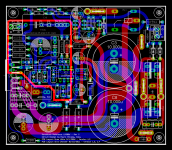I don't think he will answer....
yes, no answer. I even tried on other forums but to no avail.
Do someone got one 1.04 pcb left, or can at least send me BOM/schematic/layout ?
Thanks
Sorry just realised this in the MiniRef forum
Attachments
Last edited:
I still have 1 pcb.Do someone got one 1.04 pcb left, or can at least send me BOM/schematic/layout ?
Thanks
I connected the Howland resistors R9 & R31 to SGND rather than PGND for several reasons:
1) SGND is a cleaner ground than PGND - less noise and hash on it.
2) The outer-loop opamp has its feedback loop referenced to SGND. Hence, its output is referenced to SGND, and that's what drives the Howland chipamp trans-conductance section. Logically, the other (non-inverting) leg of the Howland should also be referenced to SGND.
3) Mauro did the same thing in the MyRef (referenced the Howland network to SGND), and it didn't seem to have any problems. There didn't seem to be any point in re-inventing the wheel here.
There may be additional reasons, but it doesn't come to mind right now, both due to my age, and the passage of time since I designed it. (However, there is some merit in referencing the Howland resistor networks to PGND, since the speaker returns go to PGND, and the Howland current-pump drives the speakers. I just didn't try that approach.)
1) SGND is a cleaner ground than PGND - less noise and hash on it.
2) The outer-loop opamp has its feedback loop referenced to SGND. Hence, its output is referenced to SGND, and that's what drives the Howland chipamp trans-conductance section. Logically, the other (non-inverting) leg of the Howland should also be referenced to SGND.
3) Mauro did the same thing in the MyRef (referenced the Howland network to SGND), and it didn't seem to have any problems. There didn't seem to be any point in re-inventing the wheel here.
There may be additional reasons, but it doesn't come to mind right now, both due to my age, and the passage of time since I designed it. (However, there is some merit in referencing the Howland resistor networks to PGND, since the speaker returns go to PGND, and the Howland current-pump drives the speakers. I just didn't try that approach.)
I modified the compensation scheme with interesting results. I took out the deboo integer and instead put 3k3 ohm and 4.7nf in parallel to the positive and the negative input of 1875. The amp still seem very stable with same minimal dc offset and component temperatures. However the sound is completely different. It is way more open with more air and less coloration (which what little miniref had initially i always attributed to the compensation cap). Now im just a casual hobbist but stuff like this makes me wish i had a measuring equipment.
Do you think in theory the comp scheme i used is doable? What have i done to the workings of the amp?
Do you think in theory the comp scheme i used is doable? What have i done to the workings of the amp?
Mauro used 3k3 in *series* with 1n between the inverting and non-inverting inputs of the LM3886 in the MyRef Rev C. The effect of that network was an inter-stage Zobel, and it presumably works well since nobody has given much thought to altering that.
In this case, you're suggesting 3K3 || 4n7 at the same location.
I'm not sure that the 3k3 will have any effect, since it shunts the inputs of the LM1875 (effectively already a nullator). The 4n7 may introduce a pole - I have to check that in simulation to see if it helps. My gut feel is that it will compromise the bandwidth of the Howland, as well as the whole composite feedback schema, but maybe it will still be adequate - we'll see.
In this case, you're suggesting 3K3 || 4n7 at the same location.
I'm not sure that the 3k3 will have any effect, since it shunts the inputs of the LM1875 (effectively already a nullator). The 4n7 may introduce a pole - I have to check that in simulation to see if it helps. My gut feel is that it will compromise the bandwidth of the Howland, as well as the whole composite feedback schema, but maybe it will still be adequate - we'll see.
Yes please.
And i meant 3k3 in SERiES with the cap! Apologies. So its same as the myref except the value has been raised considerably.
I did try 1nf initially but the zobel resistors (10ohm-1uf series) were heating up, suggesting instability. I also have 5pf in parallel to the 47k ohm to the grnd in the howland current pump which was suggested in the original paper which i find to tame the treble even in the original miniref
And i meant 3k3 in SERiES with the cap! Apologies. So its same as the myref except the value has been raised considerably.
I did try 1nf initially but the zobel resistors (10ohm-1uf series) were heating up, suggesting instability. I also have 5pf in parallel to the 47k ohm to the grnd in the howland current pump which was suggested in the original paper which i find to tame the treble even in the original miniref
The series inter-stage Zobel will work, but the values need to be optimized by experimentation - as you found out. 3k3 + 4n7 should work, but I'm a bit intrigued that the RC Deboo integrator can be omitted entirely and it still stays stable. It's possible that it will become marginally unstable with faster opamps in the outer loop - you may want to use some small C value like 5 pF or 10 pF and keep the integrator - it will also allow for a smaller C value in the inter-stage Zobel.
Unrelated: I entirely missed this tube-buffered MiniRef design from 3 years ago, until today, when I accidentally found it during a search here:
New Tube-buffered LM1875 based on MiniRef
It's highly workable, despite the elaborate multiple-rail PSU. The main point is that you get rid of the output trafo, speaker-specific impedance-matching and all that pain, and obtain the pure 2nd-harmonic dominant SET tube-sonics of the 12AU7. Of course, you will lose the extremely low THD of the MiniRef, but gain warm tube sonics in return - it's a worthwhile trade-off.
If I had to improve on this further, I'd use 2x LM3886 in parallel Howland, any decent single opamp for the composite outer loop, and maybe a 6J1/EF86 as the tube buffer on a monoblock board. 1/2 of 12AU7 would work, of course.
Unrelated: I entirely missed this tube-buffered MiniRef design from 3 years ago, until today, when I accidentally found it during a search here:
New Tube-buffered LM1875 based on MiniRef
It's highly workable, despite the elaborate multiple-rail PSU. The main point is that you get rid of the output trafo, speaker-specific impedance-matching and all that pain, and obtain the pure 2nd-harmonic dominant SET tube-sonics of the 12AU7. Of course, you will lose the extremely low THD of the MiniRef, but gain warm tube sonics in return - it's a worthwhile trade-off.
If I had to improve on this further, I'd use 2x LM3886 in parallel Howland, any decent single opamp for the composite outer loop, and maybe a 6J1/EF86 as the tube buffer on a monoblock board. 1/2 of 12AU7 would work, of course.
Last edited:
I actually do have lm3886 working in the miniref configuration and its bass is substantially better. If you'd like i can pm you the data and be grateful if you could look over it.
And yes i ended up putting back the deboo integer. Its not stable with majority of opamps without it. The value ive settled on is 1k5 & 47pf. Oddly tho tl072 works without the integer whereas the slower opamp ne5532 requires it.
The circuit youve found is interesting a lot because of the 47uf bp to gnd after the 47k ohm in the current pump. Ive never seen that done anywhere else and wonder what the tradeoff is to the implementation.
And yes i ended up putting back the deboo integer. Its not stable with majority of opamps without it. The value ive settled on is 1k5 & 47pf. Oddly tho tl072 works without the integer whereas the slower opamp ne5532 requires it.
The circuit youve found is interesting a lot because of the 47uf bp to gnd after the 47k ohm in the current pump. Ive never seen that done anywhere else and wonder what the tradeoff is to the implementation.
Sure, please PM me the LM3886 schematic at your convenience.
Good catch on the 47 uF BP - I missed it at first glance, and I'm not sure what it does. The Current Pump will not work as intended at DC and low frequencies, for sure.
The other seemingly superfluous portion is the BJT current source at the *plate* of the 12AU7. The plate could be just hooked to +30V - or alternatively, the CCS should be on the cathode leg if he was looking for better linearity.
Good catch on the 47 uF BP - I missed it at first glance, and I'm not sure what it does. The Current Pump will not work as intended at DC and low frequencies, for sure.
The other seemingly superfluous portion is the BJT current source at the *plate* of the 12AU7. The plate could be just hooked to +30V - or alternatively, the CCS should be on the cathode leg if he was looking for better linearity.
- Home
- Amplifiers
- Chip Amps
- MiniRef Schematic and PCB layout

